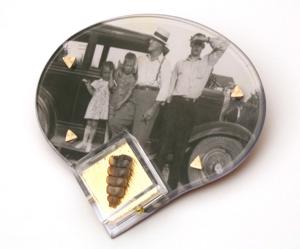
Susan Cummins: Why did you choose the title Smiling Faces?
Nancy Worden: A few years ago, my cousin was visiting and we were looking at old family photo albums. She made a comment about a group picture from the early 1970s of herself, her parents, and her siblings. Everyone in the picture was dressed up and smiling, but my cousin’s remark was, “I was SO miserable that day.”
People will smile for a camera because that is what is expected of them, regardless of how they’re feeling at that moment. I’m interested in the stories behind the smiles.
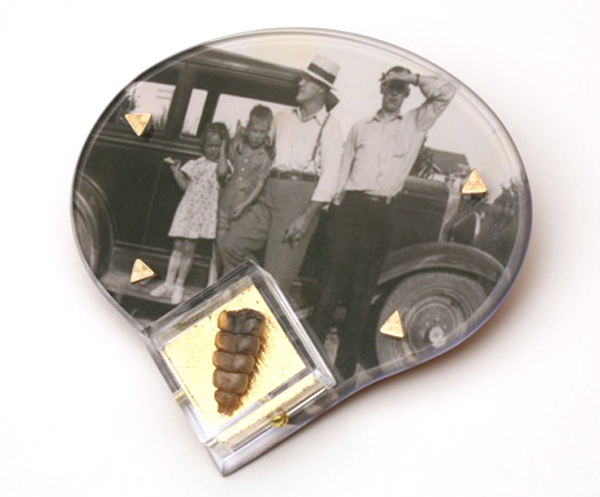
Susan Cummins: Why did you choose the title Smiling Faces?
Nancy Worden: A few years ago, my cousin was visiting and we were looking at old family photo albums. She made a comment about a group picture from the early 1970s of herself, her parents, and her siblings. Everyone in the picture was dressed up and smiling, but my cousin’s remark was, “I was SO miserable that day.”
People will smile for a camera because that is what is expected of them, regardless of how they’re feeling at that moment. I’m interested in the stories behind the smiles.
In your statement about the show, you said that Billy Collins’s poem The Revenant determined your approach to the photos you found in a box in your Grandmother’s estate. Can you quote some part of the poem that was significant, and tell us a little about your reaction to it?
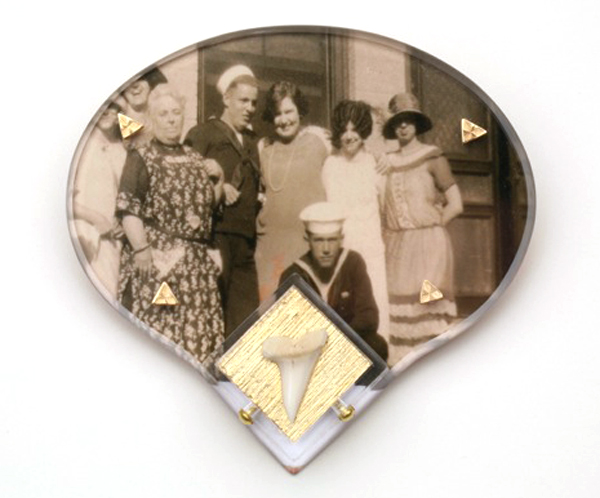
I am the dog you put to sleep,
as you like to call the needle of oblivion,
come back to tell you this simple thing:
I never liked you—not one bit.
At the reading I attended, Collins talked about teaching people to write poetry. He discourages his students from baring their inner soul in a poem and suggests that they write about their dog or something. However, he cautioned, it’s tough to write a poem about a pet without getting smarmy. The Revenant was his solution to that problem.
When I heard him read the poem, I realized I was ready to work with the cute kitty and doggie pictures. If I told the stories from the pets’ point of view, I could be sarcastic and avoid being smarmy.
You have added a wasp, a rattlesnake rattle, scorpions, and a shark’s tooth to the photographs on the brooches. Do these objects represent an extension of the phobias you addressed in previous work? How do they inform the photos?
Nancy Worden: The specimens were not intended to address a phobia, but that explanation would work. When we used to shoot film, we often used a special filter over the camera lens to correct the lighting. The specimens function as an ominous filter to correct the mood in the photograph. René Lalique has always been a hero of mine, and people remember his jewelry for its graceful curves and references to nature. He celebrated the beauty of nature, but he was also known to show its sinister side. He designed at least one entire piece about wasps. I think he was deliberately trying to offset the sweetness and predictable loveliness of Art Nouveau with an occasional stinger.
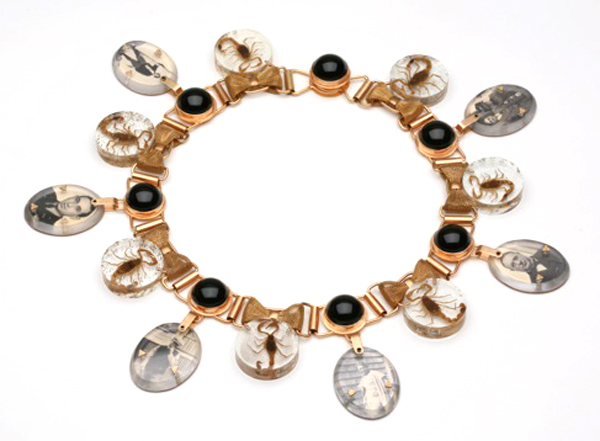
Nancy Worden: The Family Reunion started out as a cathartic outlet for a specific incident. I don’t know any of the people in the pictures. They were chosen as archetypes. The narratives on the back are very close to the kinds of remarks my Grandmother Clark made about people in her family, but the images came from my Grandmother Worden’s estate. This is not the first time I’ve used my work to try to make myself laugh about something that made me mad.
What I try to do as an artist is interpret human behavior in such a way that the imagination of my audience will be stimulated. I want people to see themselves and their own lives in the work, and quite often that does happen. In that way my work can become a personal talisman for the owner. When people wear it, they add their own content to the work. My job is to start the conversation.
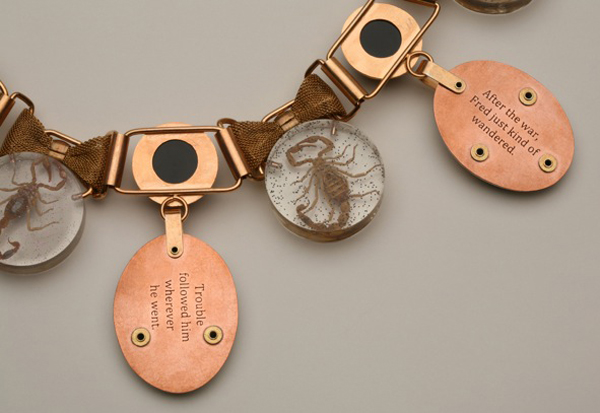
Nancy Worden: I think that if you believe that a piece of jewelry will heal or protect you, then the psychological power of that belief could help you. I am thinking about those images of men preparing for battle in Angela Fisher’s book Africa Adorned. They are wearing shirts with amulets sewed all over them for protection. There is no way those little packets made of paper and leather could stop a bullet, however, if they empower the warrior, then they have served their purpose. When I make or give an amulet to someone, what I am saying to them is, “I care about you.” There is a lot of curative power in knowing someone cares about you.
Many times in the past your work seemed to have mythical or heavy political themes. These pieces seem more personal. Any reason for the shift? What issues are on your mind today?
Nancy Worden: This body of work may be more intimate than others I’ve made, but it is a stepping stone toward a deeper archetypal topic, which is what I’m working on now. It takes a while to find the core of something. I keep going back to mythology because those stories have survived a long time. They address issues in human behavior that are still relevant.
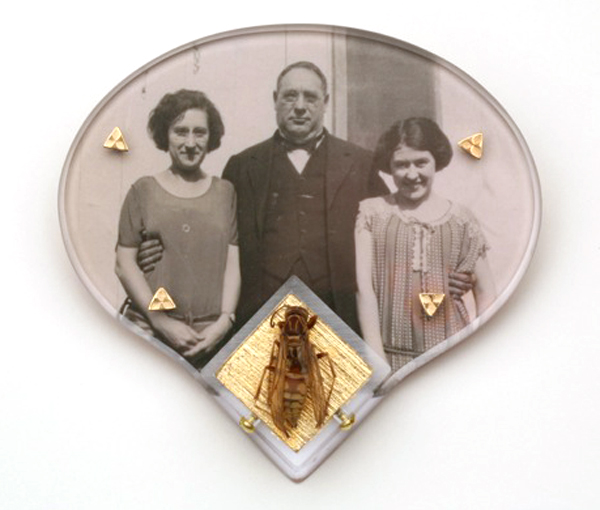
After seeing a high-definition live transmission of Die Valkyrie from the Metropolitan Opera, I had nightmares for several weeks. The imagery from the story gave me a way to wrap my mind around a very painful topic and address it in my visual vocabulary.
What are you recommending to friends to read right now?
Nancy Worden: The Greater Journey: Americans in Paris by David McCullough. Everyone I have recommended it to raves about it.
Thank you.




